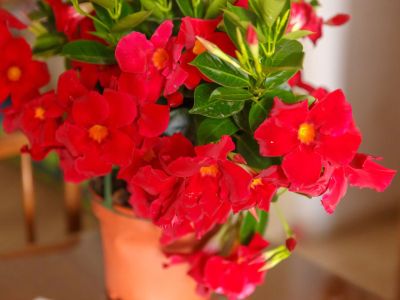Mandevilla plants in winter survive the season in fine shape if you live in a tropical climate that falls within the temperature ranges of USDA plant hardiness zones 9 and above. However, if you live in a more northern climate, planting the vine in a container is the best way to go. This tropical plant won’t tolerate temperatures below 45 to 50 degrees F. (7-10 C.) and must be wintered indoors.
How to Overwinter Mandevilla as a Houseplant
Bring a potted mandevilla plant indoors before the mercury drops below 60 degrees F. (15 C.) and grow it as a houseplant until temperatures rise in spring. Trim the plant to a manageable size and put it where it gets plenty of bright sunlight. Room temperatures are fine. Water the plant every week and trim as needed to maintain the desired size and shape. Don’t expect blooms; the plant isn’t likely to bloom during the winter.
Winterizing Mandevillas
If you’re short on bright light or space, you can bring the mandevilla indoors and store it in a dormant state. Put the plant in the sink and drench the soil thoroughly to wash out pests that may be lurking in the potting mix, then cut it back to about 10 inches (25 cm.). If you don’t want to trim it back, you may notice yellowing with subsequent leaf drop– this is normal. Place the plant in a sunny room where temperatures are between 55 and 60 degrees F. (12-15 C.). Water sparingly throughout the winter, providing only enough moisture to keep the potting mix from becoming bone dry. When you see early spring growth indicating the plant is breaking dormancy, move the mandevilla to a warm, sunny room and resume normal watering and fertilization. Either way you decide to winter your mandevilla, don’t move it back outdoors until temperatures are consistently above 60 degrees F. (15 C.). This is also a good time to move the plant to a slightly larger pot with fresh potting mix.
